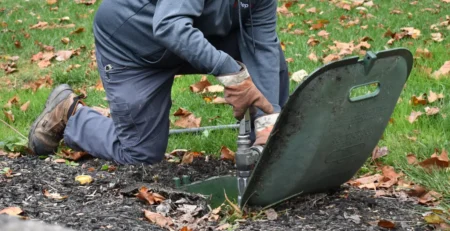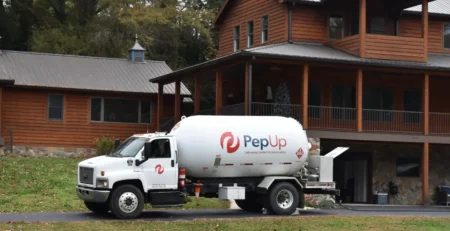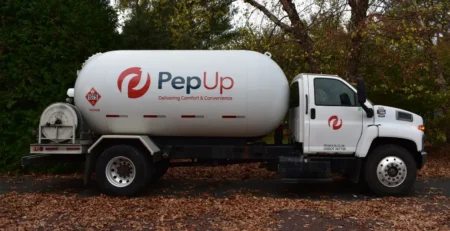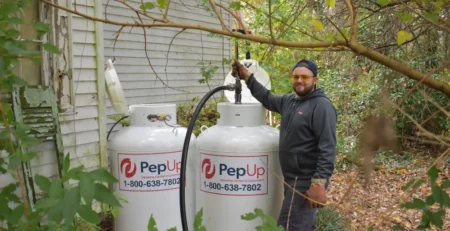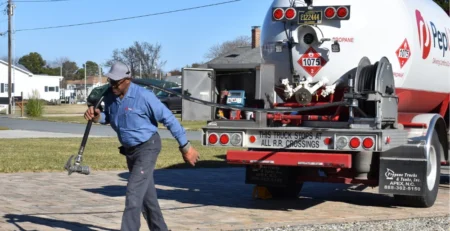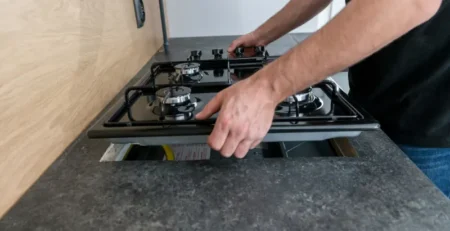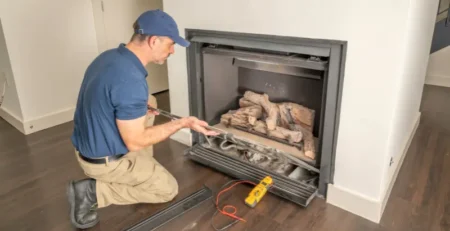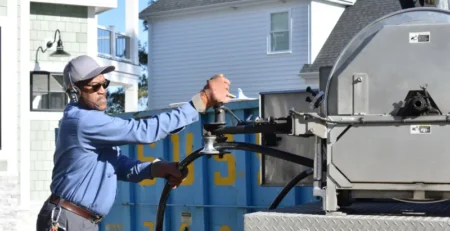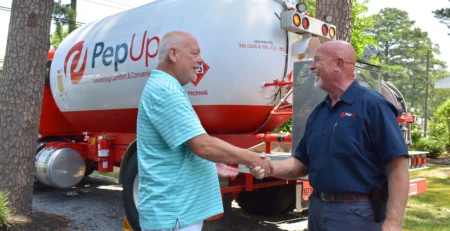A complete guide to choosing the best pole barn heaters
Pole barn heaters need to meet some requirements that are unique to these popular building styles:
- They need to circulate heat to compensate for high ceilings;
- They should be mounted relatively high, for safety; and,
- They should have intuitive, ground-level user controls.
Add to this a need for high-efficiency propane use for heating, and shopping for a barn heating solution isn’t as simple as shopping for a portable heater.
First, let’s cover a few basics. You obviously know what a pole barn is and have one that you need to heat, so we won’t dive into the history of its applications and standard features. We’re wanting to heat a large, uninsulated barn with high ceilings.
Here’s how we approach that mission, on any scale and for any application, whether you have a suburban workshop, a hobby farm, or a large agricultural business.
Jump ahead to:
- Calculate your region’s heating degree days
- Determine how warm your barn needs to be
- Decide between radiant and forced air heat, and determine mounting location
- CALCULATOR TOOL: Calculate how many BTUs you need
- Sample Option A: Radiant Tube Heater (Ceiling Mount)
- Sample Option B: Radiant Concentrated Area Heater (Wall Mount)
- Install your heater safely
- Call on PepUp with questions
Step 1: Calculate your area’s heating needs
The U.S. Energy Information Administration (EIA) offers a map for determining the average number of Heating Degree Days (HDDs) in your area. Energy Star has a calculator to determine HDDs from data collected at your nearest weather station.
Since we serve residents on Delmarva, and in our Wilmington, Glen Burnie, and Annapolis service areas, we used a couple of these tools to calculate the HDDs for our area.
In all of 2023, the Salisbury-Wicomico County weather station recorded 3830.5 degrees required to bring the outdoor temperature up to the standard base of 65 degrees. That means if you were going to heat your barn to 65 degrees (which most people wouldn’t, unless it’s used for growing plants or young poultry, in which case your heating needs would be much different), you would need to run your heater for nearly 190 days out of the year, primarily between October and May.
In our area, the months you’ll probably need to run your pole barn heater around-the-clock to hit that 65 degree mark are November through March.
Step 2: Determine what you’ll keep in your barn
Those stats aren’t a surprise to anyone who’s made it through a Mid-Atlantic winter. The big take-away is that heating a large, open, uninsulated space is going to take more energy than heating a small shed or an insulated building. To determine how much you’ll be using your barn heater system, you need to ask a few key questions that will help you determine what temperature you don’t want your barn to drop below:
- How big is your barn? You’ll need to know not just the footprint, but also the volume of your barn in cubic feet. Calculating how much power you’ll need to heat your barn looks like this formula from Farmer Boy: (cubic feet of space) x (desired temperature change in Fahrenheit) x .133 = BTUs needed per hour. That will help you determine minimum BTUs (British Thermal Units) you’ll consider in a pole barn heater or heating system, and it will also help you calculate the cost of fuel to run it.
- Are you keeping livestock in your barn? They’ll have different temperature requirements depending on their species, size, cold-hardiness, workload, and health factors like age and illness. Dairy cows have different heating needs than blanketed horses, and poultry heating and ventilation needs are far too detailed to go into in this post.
- Do you need to keep water from freezing? If so, are you heating uninsulated pipes that are run against outside walls, or are your pipes insulated or run through a concrete floor? Do you have open stock tanks of water, and are they near a north-facing wall? Consider each water source or supply line within the context of its own microclimate, and adjust your heating plan to keep the coldest pipe location from getting anywhere near freezing.
- Are you using your barn for storage, or as a workshop? If so, what are you storing, and does it need to be kept from freezing? Is anything in your barn flammable, and where will it be stored in relation to the primary heat source(s)?
Once you understand how much you’ll be using your barn heater, you’ll be able to calculate the cost of heating your pole barn by factoring in the power and efficiency of each propane heater you’re considering.
Why propane? It’s efficient, burns clean, and is safe and affordable to boot.
Step 3: Decide which style of heater you’ll be using
First, you need to understand that we’re not considering portable propane heaters for the purpose of this guide. We’re only addressing permanently mounted propane heating systems. Where those are concerned, there are two main types of heat distribution: radiant and convection/forced-air heaters.
Among livestock raisers and pole barn manufacturers, radiant heaters are the most popular for the wide open spaces within a pole barn. Instead of heating the air, these heaters transfer heat to nearby surfaces. This allows for more even and direct heating without hot spots, and can transfer heat to a concrete floor for even greater efficiency, once the floor is heated to a certain temperature.
Most any heater that is mounted up high – best practice for barns with animals and combustible materials like hay – needs to have reflective panels behind it to direct the heat downward. Heat naturally wants to rise, so reflecting back down to the floor will help limit wasting heating fuel.
Of course, adding insulation or a radiant barrier to your barn roof and walls will make it easier and less expensive to heat to your minimum temperature. That may be cost prohibitive, but the benefits in cost savings over the years could prove to be worthwhile. It’s something to consider as you look for ways to keep your pole barn warmer in the winter.
Step 4: Calculate BTU needs for your barn before you shop
Finally, once you’ve established the size of your barn and these other basic factors, you can start shopping for a pole barn heater that works best for you.
Assuming we have an uninsulated, metal pole barn that is 30 x 40 x 10, for a total of 13,600 cubic feet, heated to 50 degrees on a 35 degree day (no doors left open), how many BTUs do we need, at a minimum? Using the formula above and our make-believe pole barn and temperature, we can calculate:
13,600 (cubic feet of our barn) x 15 (degrees of temperature increase from outside temps) x .133 (propane efficiency factor) = 27,132 BTUH
Conclusion: The heater for this imaginary pole barn should be at least a 28,000 BTU heater.
Use the calculator tool below to enter your barn dimensions, your lowest historical regional temperature, and the temperature you want your barn to maintain. The result will be the minimum BTUs you’ll need, in total, from the heaters in your barn.
Sample Option A: Tube Heater, Radiant
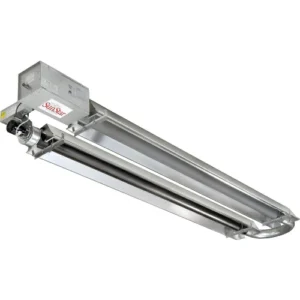
Model: SunStar SIR Series Propane Infrared Compact U Tube Heater
Specs: 15′ Tube Length, Integrated Deflector, Ceiling Mount, Electric Required
Rating: 35,000 BTU
Price: $1,075 (from Global Industrial)
Operations cost: Propane gas provides 91,547 BTUs per gallon, so this unit uses .383 gallons of propane per hour of operation. At maximum heating around the clock, this heater will burn 9.18 gallons of propane per day, at a total cost of $27.44 to operate.
Sample Option B: Concentrated Area Heater System, Radiant

Model: Heatstar HS Series Propane Garage Shop Heater
Specs: Wall Mount, No Electric Required
Rating: 22,000 BTU
Price: $1,030 (for two heaters, at $515 each from Global Industrial)
Operations cost: A single unit wouldn’t quite meet our BTUH requirements for the space, but two units – mounted to direct the most heat where it’s most needed – total 44,000 BTUH at peak capacity, burning .481 gallons of propane per hour. In 24 hours, these heaters would burn 11.54 gallons of propane, at a total cost of $34.49 to operate.
Why consider smaller heaters that, in total, cost more to operate? It’s all about location. Creating a heating system for your pole barn that utilizes smaller propane heaters, placed in strategic locations throughout your barn, could be a more efficient – and comfortable – solution. It all comes down to your needs. You’ll also notice that Option A requires electrical, and Option B doesn’t. That’s an important consideration if you need your barn heat to work, even if the power is out.
This isn’t an all-inclusive list of costs associated with pole barn heater installation. The purchase price and operating costs are important, but you also need to get price estimates for installation, propane gas line connection, and a new or upgraded propane tank to supply enough fuel for the heaters you choose. Or, talk to PepUp about setting up Automatic Delivery based on those numbers to keep your barn heated, without interruption. We can even monitor the propane levels in your tank so you never run out.
Step 5: Plan for safe installation and operation
Anytime you’re heating a space with combustible fuel, you need to ensure that you’ve addressed safety concerns that apply to any space. For pole barn heating, you’ll also need to consider special circumstances that will or may apply in your barn.
Here’s a safety checklist you should consider when comparing heater options, and discuss with your installation provider and propane company technician:
- Proper ventilation – Usually not an issue in pole barns without tight building envelopes, but ask the question of your installer.
- Safety shut-offs, tip-over protection, and CO detectors – Make sure your heating system has these features, where applicable, and that you know how to shut off the system and turn off the propane quickly.
- Installation clearance – Every heater has its own minimum clearance specifications from ceilings, walls, the floor, and from combustible materials. Pay attention to potential “hot spots” in your chosen mounting location, for your model of heater.
- Animal interference – If you have animals, you know they’ll get into anything that they can reach. Make sure you secure and enclose gas lines, electrical connections, control panels, and of course the heating unit itself, so animals can’t cause potentially devastating damage to your heating system.
Remember: PepUp can help!
We hope all this information helps you decide how you’ll approach selecting and installing pole barn heaters for your workshop, farm, or commercial business. Throughout that process, remember that PepUp Energy Specialists are a valuable resource. We can find the answers you need and share referrals to local businesses that can also be of help to you, for residential or commercial needs. Give us a call!

Meet PepUp Contributor and West District Salesman, David Brohawn
David Brohawn has been with our family of companies since Halloween Day in 2005. He lives in Cambridge, where his son owns and operates the RAR breweries. David loves to play tennis and pickleball.


